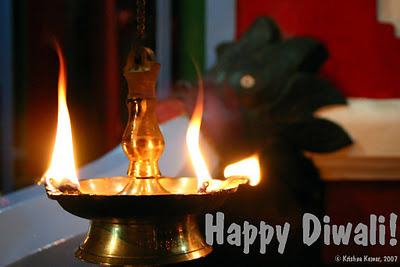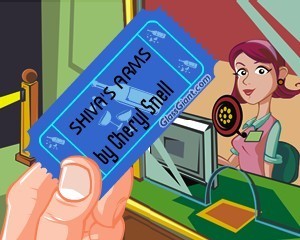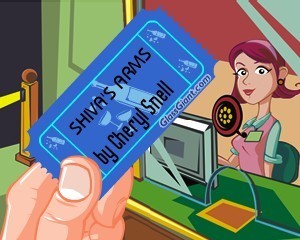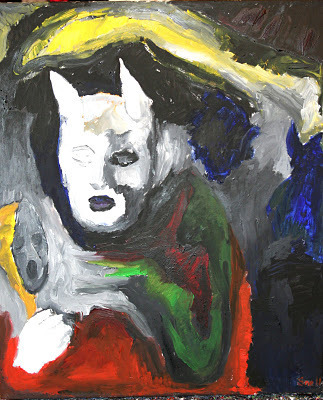Cheryl Snell's Blog, page 20
November 6, 2011
Intermission
Intermission
November 5, 2011
November 3, 2011
The Centrifugal Eye, Live!
Read it here
November 1, 2011
Man Asian Literary Prize
That's the longlist. Who do you like for the prize? Razia Iqbal, chair of the judging panel, says what connects these books is a thing that happens when we read good fiction: the cumulative impact of sentence after good sentence is transforming for the reader.
October 30, 2011
BOO
October 28, 2011
HIS DEAD WIFE'S PHOTOGRAPH, a ghost story
(by S. Mukerji)
This story created a sensation when it was first told. It appeared in the papers and many big Physicists and Natural Philosophers were, at least so they thought, able to explain the phenomenon. I shall narrate the event and also tell the reader what explanation was given, and let him draw his own conclusions.
This was what happened.
A friend of mine, a clerk in the same office as myself, was an amateur photographer; let us call him Jones.
Jones had a half plate Sanderson camera with a Ross lens and a Thornton Picard behind lens shutter, with pneumatic release. The plate in question was a Wrattens ordinary, developed with Ilford Pyro Soda developer prepared at home. All these particulars I give for the benefit of the more technical reader.
Mr. Smith, another clerk in our office, invited Mr. Jones to take a likeness of his wife and sister-in-law.
This sister-in-law was the wife of Mr. Smith's elder brother, who was also a Government servant, then on leave. The idea of the photograph was of the sister-in-law.
Jones was a keen photographer himself. He had photographed every body in the office including the peons and sweepers, and had even supplied every sitter of his with copies of his handiwork. So he most willingly consented, and anxiously waited for the Sunday on which the photograph was to be taken.
Early on Sunday morning, Jones went to the Smiths'. The arrangement of light in the verandah was such that a photograph could only be taken after midday; and so he stayed there to breakfast.
At about one in the afternoon all arrangements were complete and the two ladies, Mrs. Smiths, were made to sit in two cane chairs and after long and careful focussing, and moving the camera about for an hour, Jones was satisfied at last and an exposure was made. Mr. Jones was sure that the plate was all right; and so, a second plate was not exposed although in the usual course of things this should have been done.
He wrapped up his things and went home promising to develop the plate the same night and bring a copy of the photograph the next day to the office.
The next day, which was a Monday, Jones came to the office very early, and I was the first person to meet him.
"Well, Mr. Photographer," I asked "what success?"
"I got the picture all right," said Jones, unwrapping an unmounted picture and handing it over to me "most funny, don't you think so?" "No, I don't ... I think it is all right, at any rate I did not expect anything better from you ...", I said.
"No," said Jones "the funny thing is that only two ladies sat ..." "Quite right," I said "the third stood in the middle."
"There was no third lady at all there ...", said Jones.
"Then you imagined she was there, and there we find her ..." "I tell you, there were only two ladies there when I exposed" insisted Jones. He was looking awfully worried.
"Do you want me to believe that there were only two persons when the plate was exposed and three when it was developed?" I asked. "That is exactly what has happened," said Jones.
"Then it must be the most wonderful developer you used, or was it that this was the second exposure given to the same plate?"
"The developer is the one which I have been using for the last three years, and the plate, the one I charged on Saturday night out of a new box that I had purchased only on Saturday afternoon."
A number of other clerks had come up in the meantime, and were taking great interest in the picture and in Jones' statement.
It is only right that a description of the picture be given here for the benefit of the reader. I wish I could reproduce the original picture too, but that for certain reasons is impossible.
When the plate was actually exposed there were only two ladies, both of whom were sitting in cane chairs. When the plate was developed it was found that there was in the picture a figure, that of a lady, standing in the middle. She wore a broad-edged dhoti (the reader should not forget that all the characters are Indians), only the upper half of her body being visible, the lower being covered up by the low backs of the cane chairs. She was distinctly behind the chairs, and consequently slightly out of focus. Still everything was quite clear. Even her long necklace was visible through the little opening in the dhoti near the right shoulder. She was resting her hands on the backs of the chairs and the fingers were nearly totally out of focus, but a ring on the right ring-finger was clearly visible. She looked like a handsome young woman of twenty-two, short and thin. One of the ear-rings was also clearly visible, although the face itself was slightly out of focus. One thing, and probably the funniest thing, that we overlooked then but observed afterwards, was that immediately behind the three ladies was a barred window. The two ladies, who were one on each side, covered up the bars to a certain height from the bottom with their bodies, but the lady in the middle was partly transparent because the bars of the window were very faintly visible through her. This fact, however, as I have said already, we did not observe then. We only laughed at Jones and tried to assure him that he was either drunk or asleep. At this moment Smith of our office walked in, removing the trouser clips from his legs.
Smith took the unmounted photograph, looked at it for a minute, turned red and blue and green and finally very pale. Of course, we asked him what the matter was and this was what he said:
"The third lady in the middle was my first wife, who has been dead these eight years. Before her death she asked me a number of times to have her photograph taken. She used to say that she had a presentiment that she might die early. I did not believe in her presentiment myself, but I did not object to the photograph. So one day I ordered the carriage and asked her to dress up. We intended to go to a good professional. She dressed up and the carriage was ready, but as we were going to start news reached us that her mother was dangerously ill. So we went to see her mother instead. The mother was very ill, and I had to leave her there. Immediately afterwards I was sent away on duty to another station and so could not bring her back. It was in fact after full three months and a half that I returned and then though her mother was all right, my wife was not. Within fifteen days of my return she died of puerperal fever after child-birth and the child died too. A photograph of her was never taken. When she dressed up for the last time on the day that she left my home she had the necklace and the ear-rings on, as you see her wearing in the photograph. My present wife has them now but she does not generally put them on."
This was too big a pill for me to swallow. So I at once took French leave from my office, bagged the photograph and rushed out on my bicycle. I went to Mr. Smith's house and looked Mrs. Smith up. Of course, she was much astonished to see a third lady in the picture but could not guess who she was. This I had expected, as supposing Smith's story to be true, this lady had never seen her husband's first wife. The elder brother's wife, however, recognized the likeness at once and she virtually repeated the story which Smith had told me earlier that day. She even brought out the necklace and the ear-rings for my inspection and conviction. They were the same as those in the photograph.
All the principal newspapers of that time got hold of the fact and within a week there was any number of applications for the ghostly photograph. But Mr. Jones refused to supply copies of it to anybody for various reasons, the principal being that Smith would not allow it. I am, however, the fortunate possessor of a copy which, for obvious reasons, I am not allowed to show to anybody. One copy of the picture was sent to America and another to England. I do not now remember exactly to whom. My own copy I showed to the Rev. Father —— m.a., d.sc., b.d., etc., and asked him to find out a scientific explanation of the phenomenon. The following explanation was given by the gentleman. (I am afraid I shall not be able to reproduce the learned Father's exact words, but this is what he meant or at least what I understood him to mean).
"The girl in question was dressed in this particular way on an occasion, say 10 years ago. Her image was cast on space and the reflection was projected from one luminous body (one planet) on another till it made a circuit of millions and millions of miles in space and then came back to earth at the exact moment when our friend, Mr. Jones, was going to make the exposure.
"Take for instance the case of a man who is taking the photograph of a mirage. He is photo graphing place X from place Y, when X and Y are, say, 200 miles apart, and it may be that his camera is facing east while place X is actually towards the west of place Y."
In school I had read a little of Science and Chemistry and could make a dry analysis of a salt; but this was an item too big for my limited comprehension.
The fact, however, remains and I believe it, that Smith's first wife did come back to this terrestrial globe of ours over eight years after her death to give a sitting for a photograph in a form which, though it did not affect the retina of our eye, did impress a sensitized plate; in a form that did not affect the retina of the eye, I say, because Jones must have been looking at his sitters at the time when he was pressing the bulb of the pneumatic release of his time and instantaneous shutter.
The story is most wonderful but this is exactly what happened. Smith says this is the first time he has ever seen, or heard from, his dead wife. It is popularly believed in India that a dead wife gives a lot of trouble, if she ever revisits this earth, but this is, thank God, not the experience of my friend, Mr. Smith.
It is now over seven years since the event mentioned above happened; and the dead girl has never appeared again. I would very much like to have a photograph of the two ladies taken once more; but I have never ventured to approach Smith with the proposal. In fact, I learnt photography myself with a view to take the photograph of the two ladies, but as I have said, I have never been able to speak to Smith about my intention, and probably never shall. The £10, that I spent on my cheap photographic outfit may be a waste. But I have learnt an art which though rather costly for my limited means is nevertheless an art worth learning.
October 24, 2011
Diwali!

Diwali (Deepavali, in the south) is now upon us. Deepa in Sanskrit means 'light' and avali means 'a row', and all of India is ablaze with fireworks, candles, and oil lamps.
The lights recall how villagers set out diyas to guide Rama home after vanquishing Ravana, the return from exile that forms the basis for the Diwali celebration. Oil lamps such as the ones pictured decorate thresholds during the Festival of Lights to welcome Goddess Lakshmi, also. Lakshmi is the goddess of wealth, and devotees worship her with oil, turmeric, soil from the River Ganga, grains, durba grass, flowers, and festive vegetarian dishes – khichuri, naru, narkel bhaja, chirey and taaler phopol. Worshippers may stay awake all night, awaiting the goddess.
The word 'Lakshmi' is derived from the Sanskrit word Laksya, meaning 'goal'. The goddess is usually depicted with four hands, representing dharma (righteousness), kama (desires), artha (wealth), and moksha (liberation from the cycle of birth and death). As a female counterpart of Lord Vishnu, Mata Lakshmi is also called 'Shri', the female energy of the Supreme Being.
Diwali is a five-day festival, but my husband recalls that his family condensed it into one. The best part for him as a boy was the setting off of firecrackers. His brothers and he would wake in the dark, and go across the courtyard of the Om building to the gymkhana where there was a long fence. They would place the flowerpot fireworks on the vertical metal rods and set a line of Atomic Bombs burning along the chain link row. Dangerous, but thrilling! Then the children would go back home and take a ritual bath with gingerly oil, and powder. Breakfast was muruku, jalaibees or halwa. Dessert for breakfast—what's not to love? Gift-giving came next, with brand new clothes. In this household, there was no gambling, although it is practiced in some families, in honor of Parvati's famous dice games with Shiva.
Desserts like those just mentioned are a huge part of the Diwali celebration. A favorite at our house is halwa. It is all things to all people, this dessert--a pudding or fudge. In some recipes, it's based on semolina, like the southern version called Kesari, and has a texture like gelatin. Other versions use carrots or mung beans.
Halwa is not just for eating. Apparently, you can tease with it as well. In Tamil Nadu, if you ask someone "Are you trying to give me halwa?" you are asking if he's trying to outsmart you. In Mumbai, the word is used to imply simple. "Halva hai kya?" means "Is it that simple?" In the north, halwa means a mish-mash. "Halwa bana diya" means "you made a Halwa out of it".
Let's just eat the thing, shall we? Heat 1/2 cup unsalted butter at medium heat. Add 1 cup cream of wheat. The mixture should turn a pink/ gold color. Add 2 cups water. Stir quickly --no lumps! Add 1 cup sugar, raisins and cashews. And have a happy Diwali from Shiva's Arms!






